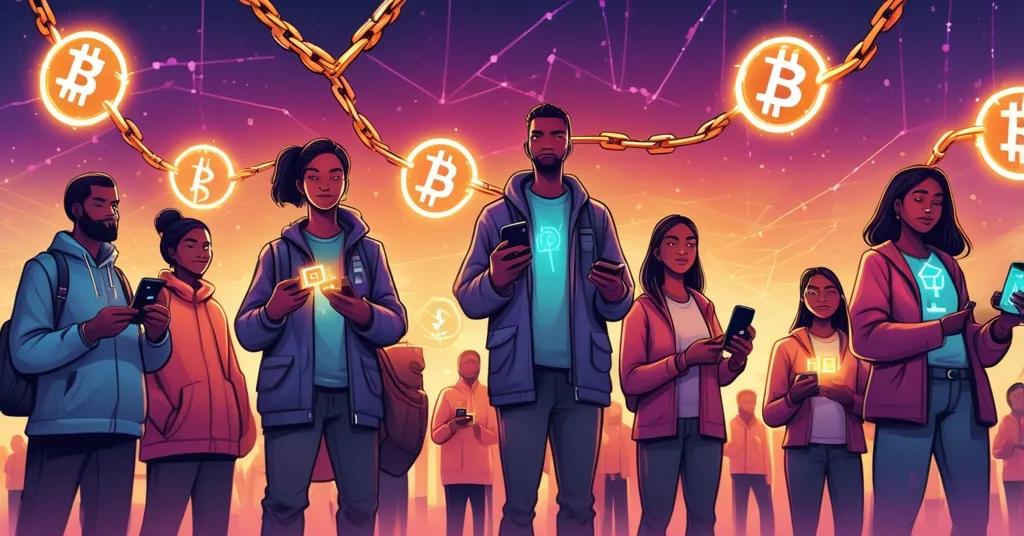DeFi Coalition Unveils $30B Blockchain Plan to Combat Global Poverty

DeFi Coalition Proposes $30 Billion Plan to Slash Global Poverty with Blockchain Power
A groundbreaking initiative spearheaded by the DeFi Education Fund (DEF), backed by heavyweight crypto policy groups, has dropped a $30 billion bombshell plan to tackle global poverty head-on. Using decentralized finance (DeFi) tools built on blockchain technology, this coalition aims to dismantle the suffocating financial fees that trap the world’s poorest, offering a lifeline through cheaper remittances, payments, and transfers for those sidelined by traditional banking.
- Main Goal: Slash the “poverty premium” with DeFi, saving unbanked populations up to $30 billion annually.
- Target Crisis: Address the financial exclusion of 808 million in extreme poverty and millions more struggling.
- Policy Fight: Push for regulatory clarity in Washington to safeguard DeFi innovation for the marginalized.
The Crushing Weight of the Poverty Premium
Let’s get straight to the gut punch: in 2025, a staggering 808 million people survive on less than $3 a day, trapped in extreme poverty, while another 887 million face multidimensional poverty—think empty pockets compounded by climate disasters, political chaos, and economic collapse. These aren’t just numbers; they represent real lives locked out of financial systems most of us take for granted. In the U.S. alone, 5.6 million households are unbanked, with no access to a bank account, and 14.2% are underbanked, scraping by with limited services. Globally, the story is even grimmer, with millions relying on predatory financial alternatives that bleed them dry.
This is where the “poverty premium” kicks in—a brutal, hidden tax on the poor. Low-income U.S. households shell out 7.1% of their annual income on fees for basics like cashing a paycheck (which can cost up to 5% of its value) or sending money abroad via remittances. Compare that to the measly 0.2% wealthier households pay, and you see the scam of a system rigged against the bottom rung. For someone earning $20,000 a year, that’s over $1,400 lost to fees—money that could buy food, medicine, or school supplies. DeFi, as pitched by DEF through their ambitious $30 billion strategy, wants to flip this script by using blockchain to cut out greedy middlemen, promising to reduce global remittance costs by up to 80%. That’s $30 billion a year back in the pockets of the unbanked—if it works.
DeFi’s Big Promise: Financial Freedom via Blockchain
So, what exactly is DeFi? Short for decentralized finance, it’s a system built on blockchain networks—think Ethereum or Solana—where financial services like lending, borrowing, or sending money happen without banks or payment processors. Instead, self-executing digital agreements called smart contracts (imagine automated deals coded to run on their own, no middleman needed) handle transactions directly between users. For the unbanked, this means sending $200 to family overseas might cost pennies instead of $20-30 in fees. It’s like cutting out the overpriced delivery guy and getting farm-fresh produce straight to your door—cheaper, faster, direct.
DEF’s $30 billion plan isn’t just hot air. It targets the pain points of financial exclusion by funding infrastructure, education, and access to DeFi tools. The idea is to deploy these solutions in high-impact areas—think rural villages or urban slums—where traditional banking either doesn’t exist or preys on desperation. Beyond remittances, DeFi could offer low-cost payments, transfers, and even savings options, all accessible via a smartphone or basic internet. The savings potential is massive: $30 billion annually could transform lives, turning survival into opportunity for millions.
Real-World Proof: Crypto as a Lifeline
This isn’t some pie-in-the-sky fantasy—people are already using crypto and DeFi to survive broken systems. In Venezuela, where hyperinflation turns the bolívar to dust overnight, folks use digital currencies to preserve what little savings they have. In Zimbabwe and Argentina, blockchain networks are a shield against currency collapse fueled by corruption or mismanagement. Over in Nigeria and East Africa, crypto enables cross-border transactions without the bloodsucking fees of traditional services, often with just a mobile phone. These aren’t tech bros gambling on tokens; they’re farmers, small vendors, and families dodging economic ruin, one transaction at a time.
These use cases scream potential. They’re proof that DeFi and blockchain can accelerate us past outdated, exploitative systems—if we can scale it. As Bitcoin maximalists, we at Let’s Talk Bitcoin salute the ethos of decentralization powering this fight. Bitcoin itself stands as sound money, a store of value untouchable by meddling governments or banks. But we’re not blind to the niches altcoins like Ethereum fill with programmable finance—smart contracts and complex protocols that Bitcoin doesn’t (and shouldn’t) touch. This isn’t about picking sides; it’s about a financial revolution that works for everyone.
The Ugly Truth: DeFi’s Rough Edges
Before we start chanting “DeFi to the moon,” let’s face it: this tech is a damn mess in practice. For all its promise, DeFi is riddled with barriers that could derail its poverty-fighting mission. First up, many protocols demand collateral—often you’ve got to lock up crypto worth more than you’re borrowing. Great if you’ve got assets; useless if you’re dirt poor with nothing to stake. Then there’s the rollercoaster of token markets. One crash can vaporize savings faster than any bank fee, and the unbanked can’t afford that gamble.
Security’s another nightmare. Smart contracts, while innovative, aren’t bulletproof—bugs or hacks have drained millions from DeFi platforms over the years. The average user isn’t a coder; they can’t spot a flaw before it’s exploited. And don’t get me started on usability. Navigating DeFi apps often feels like solving a Rubik’s Cube blindfolded, especially with low financial literacy in target communities. Right now, much of DeFi is a speculative playground—think risk-taking traders (or “degens,” as the crypto crowd calls them) chasing quick bucks through yield farming (lending out crypto for high, risky rewards) rather than using it for real-world needs. Even El Salvador, which made Bitcoin legal tender in 2021, shows the struggle—daily usage is a fraction of the hype, proving adoption isn’t a given.
Scaling the Unscalable: Tech and Trust Gaps
Let’s talk infrastructure. Reaching a billion people—many without reliable internet, smartphones, or basic reading skills—is a Herculean task. In rural regions, you’re lucky to get a stable 2G connection, let alone the bandwidth for blockchain transactions. Urban slums might have access, but trust is a bigger hurdle. After decades of being screwed over by systems promising help, why would anyone trust a cryptic app with their last dollar? DEF’s plan must tackle this with boots-on-the-ground education, mobile-friendly DeFi tools, and community-driven outreach. Look at projects like Stellar, already working on financial access in Africa—partnerships like these could be the bridge.
Stablecoins—crypto pegged to assets like the U.S. dollar—could help with volatility, offering a steady medium for transactions. Layer-2 solutions, tech that speeds up and cheapens blockchain transactions, might also lower the entry bar. But funding and deploying this at scale? That’s where the $30 billion comes in, though specifics on allocation—regions, tech, or partners—remain murky. Without a clear roadmap, this risks becoming another flashy crypto promise that fizzles out.
Policy Battles: Make or Break for DeFi
Here’s the kicker: DeFi can’t save anyone if regulators strangle it first. DEF knows this, which is why they’re ramping up advocacy in Washington. In August, they launched the DeFi Education Foundation to lobby lawmakers alongside players like Andreessen Horowitz (a16z), pushing the U.S. Securities and Exchange Commission (SEC) for a “safe harbor” for blockchain apps. What’s that? A legal shield so developers aren’t mislabeled as brokers and buried in lawsuits. Past SEC crackdowns on projects like Uniswap show the stakes—misclassify builders as financial intermediaries, and you kill innovation faster than a rug pull scam.
DEF, with allies like Paradigm, Jump Crypto, Multicoin Capital, the Solana Policy Institute, and the Uniswap Foundation, has also submitted input to the Senate Banking Committee on the Responsible Financial Innovation Act of 2025. Their demand: separate software creators from financial middlemen in the law. Without clear rules, DeFi stays a Wild West, scaring off the vulnerable it’s meant to help and leaving space for scammers to thrive. Public sentiment backs this fight—a DEF/Ipsos survey found 42% of Americans are open to DeFi if privacy is protected, while 56% crave full control over their money and 54% over their data. That’s a loud middle finger to centralized gatekeepers.
What Critics Say: Could DeFi Backfire?
Playing devil’s advocate, let’s hear the skeptics. Some argue DeFi might worsen inequality—only those with some capital or tech savvy can play, leaving the poorest behind. A bad hack or market dip could also ruin lives faster than any bank fee, especially for folks with no safety net. Fair points, but counterable. Education and user-friendly design can lower entry barriers, while stablecoins and community support can cushion risks. The traditional system already fails the poor—DeFi, even imperfect, offers a shot at something better. Ignoring it because it’s not flawless is like refusing a lifeboat because it’s got a small leak.
The Road Ahead: Revolution or Pipe Dream?
DeFi dangles a tantalizing vision: financial liberation for the world’s downtrodden, a middle finger to a system that’s profited off their misery for centuries. But it’s balancing on a tightrope between disruptive genius and chaotic disaster. We’re all for effective accelerationism—pushing hard to break free of broken structures—but it’s got to be grounded. Bitcoin remains the gold standard of decentralized money, a bedrock for freedom and privacy. Yet, ecosystems like Ethereum, with their programmable smart contracts, carve out vital roles in this fight. This isn’t about shilling tokens or chasing moonshot gains; it’s about impact. No hype, no bullshit—just the gritty reality of what’s at stake.
So, can DeFi truly unshackle the world’s poorest, or are we banking on a tech that’s years from readiness? That’s the question hanging over this $30 billion gamble. If DEF and its allies can bridge the tech, trust, and regulatory chasms, we might just witness the financial rebellion we’ve been waiting for. If not, it’s back to square one—only with more dashed hopes.
Key Takeaways and Questions on DeFi’s Poverty-Fighting Potential
- What is the poverty premium, and how does DeFi plan to crush it?
It’s the unfair financial hit low-income households take, spending up to 7.1% of income on fees for services like remittances or check cashing, compared to 0.2% for the wealthy. DeFi uses blockchain to bypass intermediaries, aiming to cut costs by up to 80% and save the unbanked $30 billion yearly. - How many are trapped in extreme poverty in 2025, and why does blockchain financial inclusion matter?
Over 808 million live on less than $3 a day, with 887 million more in multidimensional poverty. Blockchain financial inclusion through DeFi offers low-cost, direct access to financial tools for the unbanked, if hurdles like tech access and education are tackled. - What are the biggest roadblocks to DeFi adoption for the unbanked?
Obstacles include needing collateral to use many protocols, volatile crypto markets, hack-prone smart contracts, and complex interfaces. Speculative trading often trumps practical use, as seen in El Salvador’s slow Bitcoin uptake. - Why is regulatory clarity a dealbreaker for DeFi’s impact on global poverty?
Without clear laws, like a blockchain safe harbor, developers risk legal backlash that could choke DeFi’s growth. Regulatory clarity ensures safe scaling to bring crypto solutions for remittances and access to marginalized groups. - What do crypto use cases in Venezuela and Nigeria tell us about DeFi’s future?
In Venezuela, crypto protects savings from hyperinflation; in Nigeria, it enables cheap cross-border payments. These cases highlight DeFi’s potential for real financial relief, but scaling to billions remains a daunting challenge.



